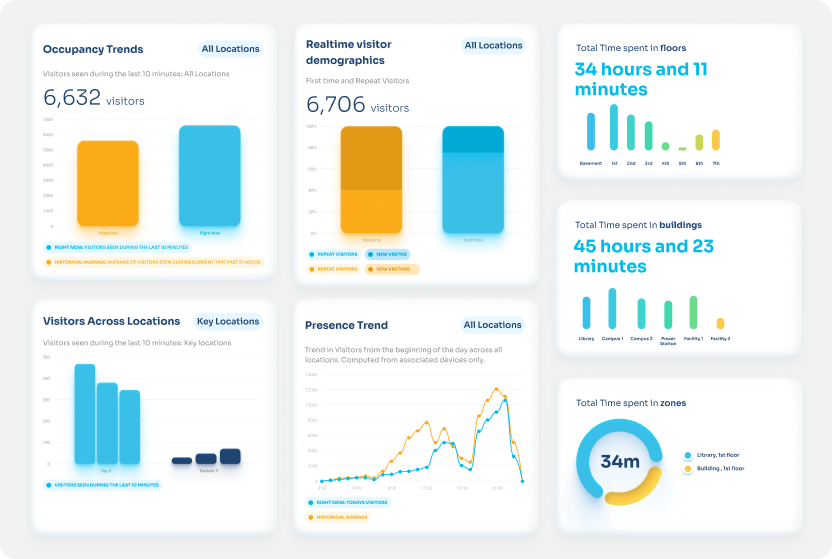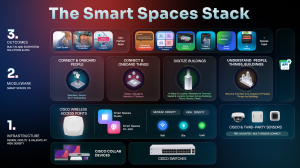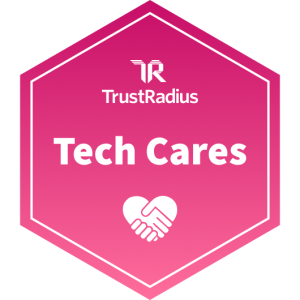
Smart buildings are revolutionizing the way we interact with our spaces by seamlessly integrating technology and design. From energy efficiency to enhanced comfort, these intelligent spaces leverage IoT, automation, and data analytics to create sustainable and user-friendly environments. Let’s explore the core technologies behind smart buildings, their transformative benefits, and the trends shaping the future of this technology.
What Is a Smart Building?
A smart building is a digitally connected environment that uses real-time data to optimize space usage, energy efficiency, and the overall experience for its occupants. It leverages tools like space utilization analytics, environmental monitoring, and intelligent workplace apps to focus on operational efficiency. By integrating these technologies, smart buildings help organizations adapt to hybrid work models, rising energy costs, and evolving employee expectations. This makes smart buildings essential in today’s dynamic work and living landscapes.
The Role of Location Analytics in Smart Building Intelligence
Location analytics data serves as the backbone of smart building intelligence, enabling informed decision-making by interpreting real-time data. Platforms like Cisco Spaces collect, visualize, and analyze occupancy patterns and environmental metrics, helping organizations optimize space utilization, enhance energy efficiency, and drive long-term planning strategies. Through actionable insights, data analytics transforms buildings into dynamic, responsive environments tailored to the evolving needs of occupants and businesses.
Core Technologies Behind Smart Buildings
Smart building technologies prioritize data visibility, automation, and the creation of people-centric environments to enhance functionality and experiences for occupants. Cisco is driving the adoption of intelligent solutions that transform buildings into adaptive, efficient ecosystems. Let’s take a look at the core technologies used by Cisco Spaces to enable smarter spaces.
Occupancy Sensing & Utilization Analytics
Occupancy sensing and utilization analytics are used to detect presence, count occupants, and measure how spaces are used in real time. Cisco Spaces enables these capabilities through Wi-Fi-based detection, providing detailed dashboards that track occupancy and usage patterns over time. This technology helps organizations optimize space allocation, enhance workplace efficiency, and support data-driven decision-making.
Environmental Monitoring Systems
Environmental monitoring systems use sensors to track key indoor air quality metrics like temperature, humidity, CO₂ levels, and more. Cisco Spaces enhances these capabilities by supporting third-party Bluetooth Low Energy (BLE) sensors, enabling seamless integration for real-time visibility into environmental conditions. This helps create smarter and healthier spaces for occupants while helping organizations respond to changing environmental needs.
Digital Mapping & Indoor Navigation Tools
Digital mapping and indoor navigation tools offer interactive indoor maps, navigation assistance, and real-time location tracking. All of this enhances user experiences within buildings. Cisco Spaces overlays occupancy and availability data onto AI-powered 3D maps, providing a dynamic visual representation of space usage. These tools improve indoor navigation, resource accessibility, and operational efficiency in smart buildings.
Workspace Reservation & Desk Booking Platforms
Workspace reservation and desk booking platforms are tools that enable users to reserve desks, meeting rooms, or shared spaces, efficiently. Cisco Spaces supports this functionality through its Smart Desking feature. It displays live availability and seamlessly integrates with workplace scheduling systems. This simplifies space management while improving flexibility and collaboration in hybrid work environments
Building Analytics & Visualization Dashboards
Building analytics and visualization dashboards aggregate data from smart building platforms to provide insights into space, environment, and occupancy trends. Cisco Spaces enhances this capability with real-time and historical dashboards. It allows facilities teams to easily visualize building usage and performance across multiple sites. These tools support informed decision-making and optimize building operations for greater efficiency.
Benefits of Building Smart, Modern Workplaces
Maximizing Space Utilization Across Connected Buildings
Space utilization analytics empower teams to identify underused areas, optimize layouts, and consolidate spaces to better match organizational needs. By leveraging detailed data, organizations can right-size their environments, reduce waste, and enhance planning across connected building portfolios. This ensures efficient use of resources while supporting dynamic workplace demands and sustainable operations.
Improving Air Quality & Supporting Indoor Wellness
Environmental monitoring tools track and manage indoor factors like temperature, humidity, and air quality to maintain a safe and comfortable environment. By supporting workplace wellness, these tools improve employee focus, reduce complaints, and foster a healthier atmosphere. Additionally, they align with broader ESG or WELL Building goals, enhancing sustainability and organizational reputation.
Boosting Building Performance & Lowering Energy Costs
Facilities teams can leverage real-time occupancy and environmental data to optimize HVAC systems, automate cleaning schedules, and minimize unnecessary energy use. These data-driven actions improve daily operational efficiency while significantly reducing energy costs over time. This not only enhances building performance but also supports sustainability goals and long-term financial savings.
Enhancing the Employee Experience in Smart Workspaces
Smart workspace tools like wayfinding, smart desking, and real-time availability streamline daily workflows by reducing friction and improving employee navigation and resource access. These features create a more intuitive, personalized environment, enhancing productivity and satisfaction. In hybrid work models, they play a crucial role in supporting flexibility and efficient workspace utilization.
Enhancing Safety and Security Across Workplaces
Smart buildings enhance workplace safety by utilizing real-time occupancy monitoring, threshold alerts, and seamless integration with existing security systems. Cisco Spaces facilitates proactive responses to crowding or unauthorized access, thereby aiding teams in maintaining compliance and reducing security risks. These measures ensure a safer and more secure work environment.
Tracking High-Value Equipment Across the Workplace
Smart buildings enable effective asset management by monitoring the real-time location and movement of high-value equipment. Cisco Spaces provides BLE-based asset tracking capabilities, allowing organizations to reduce loss, streamline recovery processes, and improve overall operational oversight. This ensures enhanced efficiency and cost control across the workplace.
Supporting Strategic Real Estate & Growth Planning
Smart building data empowers workplace leaders with actionable insights to make strategic real estate decisions based on actual space usage and trends. Historical data helps guide lease adjustments, space redesigns, and smarter capital allocation, ensuring that spaces are optimized to meet organizational needs while reducing unnecessary costs. This data-driven approach supports both agility and growth planning.
Trends Shaping the Future of Smart Buildings
Smart building technology is evolving rapidly, driven by the rise of hybrid work models, increasing sustainability goals, and the growing demand for flexibility in workplaces. These trends are reshaping how organizations design, manage, and utilize spaces to better align with modern workforce and environmental priorities.
Rise of Hybrid Work Models
Smart building tools enable organizations to support the flexibility of hybrid work models by optimizing shared spaces and accommodating dynamic schedules. These technologies provide real-time insights into space utilization and usage patterns, ensuring resources are efficiently allocated while maintaining an environment that adapts to employees’ needs.
Demand for Real-Time Workplace Data
The demand for real-time workplace data is increasing as organizations seek to adapt quickly to shifting employee needs and space requirements. Real-time space and occupancy data provide actionable insights, enabling workplaces to optimize layouts, manage capacity, and improve the employee experience with greater accuracy. This visibility ensures decisions are made proactively and efficiently.
Focus on Sustainability & Energy Use
Optimizing space utilization and environmental settings with smart building technology helps companies minimize energy waste, directly supporting both cost savings and sustainability efforts. By automating energy use based on occupancy and space needs, organizations can significantly reduce their carbon footprint. This aligns with ESG goals while promoting operational efficiency.
Digital Transformation of the Workplace Experience
Businesses are embracing digital transformation by adopting systems and apps that enable desk booking, wayfinding, and personalized space settings. These tools enhance employee autonomy by allowing individuals to tailor their work environments and easily navigate shared spaces. By streamlining hybrid work logistics, these systems and apps make workplaces more adaptable and efficient for modern workforce needs.
Greater Emphasis on Employee Experience
Modern smart buildings are increasingly designed with a focus on enhancing the employee experience, making workplaces more intuitive, responsive, and enjoyable. By leveraging technology to adapt to occupant needs—such as optimized lighting, temperature, air quality, and seamless connectivity—these buildings create environments that prioritize comfort and productivity. This people-centric approach fosters engagement and satisfaction in the modern workplace.
How Cisco Spaces Powers Smart Building Experiences
Cisco Spaces provides a flexible, network infrastructure-based platform that enables organizations to activate smart building capabilities by leveraging their existing network investments. By integrating real-time data and digital tools, it powers advanced workplace experiences such as indoor navigation and environmental optimization, driving efficiency and engagement.
Built on Existing Cisco Network Infrastructure
Cisco Spaces is built to run seamlessly on existing Cisco Catalyst and Meraki infrastructure, enabling organizations to unlock smart building functionality without requiring significant hardware upgrades. This approach minimizes deployment costs while maximizing the value of their current network investments.
Centralized Dashboards & Analytics
Cisco Spaces provides centralized dashboards and analytics that allow teams to view real-time and historical trends of multiple buildings, in one convenient location. This empowers organizations to optimize daily operations, such as space utilization and environmental adjustments, while also informing long-term strategies for workplace planning and efficiency.
App Integrations & Customization Options
Cisco Spaces offers robust app integrations and customization options, seamlessly connecting with collaboration platforms, digital signage, and third-party sensors. The Partner App Center expands the ecosystem by providing access to a wide range of third-party applications, enabling innovative use cases across industries. Additionally, the IoT Device Marketplace simplifies deployment with compatible sensors and devices. This flexibility allows organizations to tailor solutions to their specific needs, ensuring an optimized and cohesive smart building experience.
Privacy, Security & Scalability
Cisco Spaces is built with enterprise-grade privacy and security at its core, featuring opt-in policies to ensure compliance and protect user data. Its scalable architecture makes it adaptable for businesses of all sizes, allowing organizations to expand smart building capabilities as their needs evolve.
Bring Smart Building Insights to Life with Cisco Spaces
Smart buildings are transforming workplaces by leveraging software-driven insights to enhance safety, efficiency, and engagement. Cisco Spaces empowers organizations to activate these benefits using their existing Cisco network infrastructure, unlocking advanced capabilities like space optimization, environmental monitoring, and seamless asset tracking. By turning raw data into actionable outcomes, businesses can create spaces that support employee productivity, visitor experience, and operational excellence — all without significant hardware upgrades.
Visit the Cisco Spaces Experience Center to explore how data-driven smart buildings optimize space, comfort, and workplace performance.



